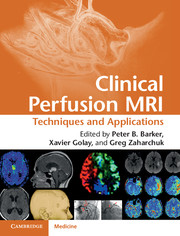Preface
Published online by Cambridge University Press: 05 May 2013
Summary
Blood flow is one of the most fundamental physiological parameters. Maintenance of adequate blood flow is vital for the health of biological tissue. The growth and function of many organ systems are linked tightly to their blood supply. In addition, many disease processes are associated with either increases or decreases in flow compared with normal values. The development and validation of non-invasive tools for the measurement of flow have been longstanding goals, both in biomedical research and in clinical practice.
Traditionally, the imaging of flow, or perfusion, has been accomplished using either nuclear medicine-based techniques involving radioactive isotopes, or X-ray computed tomography (CT) methods using radio-opaque contrast agents. However, soon after the introduction of magnetic resonance imaging (MRI) for anatomical imaging, research began on techniques for depicting flow. Since then, progress has been rapid, not least because MR methods have the advantage of not involving radiation, and in the case of arterial spin labeling-based techniques, are completely non-invasive. This makes them particularly appealing for use in a wide range of populations, including children and normal subjects. In addition, MR perfusion can be combined with the armamentarium of other structural, vascular, physiological, metabolic, and functional techniques available with MR to provide a comprehensive, “one-stop” examination for the patient.
- Type
- Chapter
- Information
- Clinical Perfusion MRITechniques and Applications, pp. xiiiPublisher: Cambridge University PressPrint publication year: 2013



